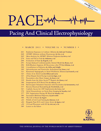Long-Term Mortality and Pacing Outcomes of Patients with Permanent Pacemaker Implantation after Cardiac Surgery
Conflicts of Interest: None of the authors had any conflicts of interest to declare in relation to this project.
Abstract
Background: Approximately 20,000 permanent pacemakers (PPMs) are implanted annually for bradycardia or atrioventricular (AV) block after cardiac surgery. Little is known about the long-term pacing and mortality outcomes and the temporal trends of these patients.
Methods: We examined 6,268 consecutive patients who underwent cardiac surgery at the Minneapolis Veterans Administration Medical Center between 1987 and 2010. Patients who had a PPM within 30 days of cardiac surgery were identified. Pacemaker interrogation records were retrospectively reviewed and mortality was ascertained.
Results: Overall, 141 (2.2%) patients underwent PPM implantation for high-degree AV block (55%) and bradycardia (45%), 9 ± 6 days after surgery. Age, diuretic use, cardiopulmonary bypass time (CPBT), and valve surgery were independent predictors of PPM requirement. After 5.6 ± 4.2 years of follow-up, 40% of the patients were PPM dependent. Longer CPBT (P = 0.03), PR interval >200 ms (P = 0.03), and QRS interval > 120 ms (P = 0.04) on baseline electrocardiogram predicted PPM dependency . In univariable analysis, PPM patients had a higher long-term mortality than those without PPM (45% vs 36%; P = 0.02). However, after adjusting for age, sex, type of surgery, and CPBT, PPM requirement was not associated with long-term mortality (hazard ratio 1.3; 95% confidence interval 0.9–1.9; P = 0.17). Compared to before, incidence of PPM implantation increased after the year 2000 (1.9% vs 2.6%; P = 0.04).
Conclusion: The majority of patients who require PPM after cardiac surgery are not PPM dependent in the long term. Requiring a PPM after surgery is not associated with long-term mortality after adjustment for patient-related risk factors and cardiac surgical procedure. (PACE 2011; 34:331–338)




